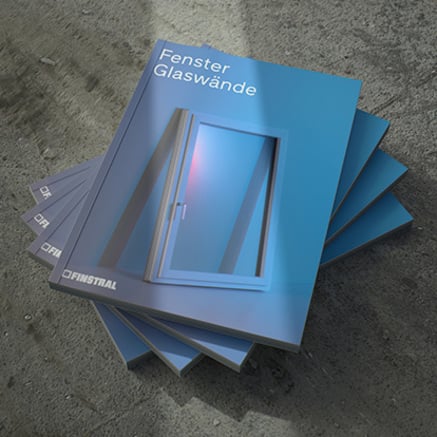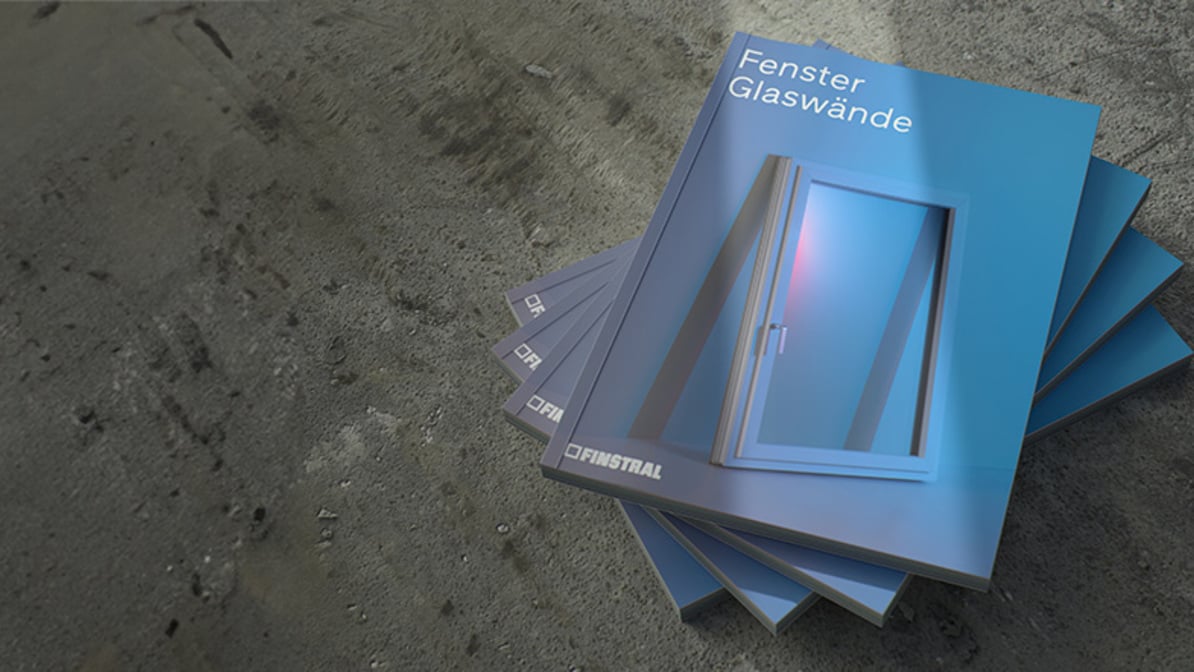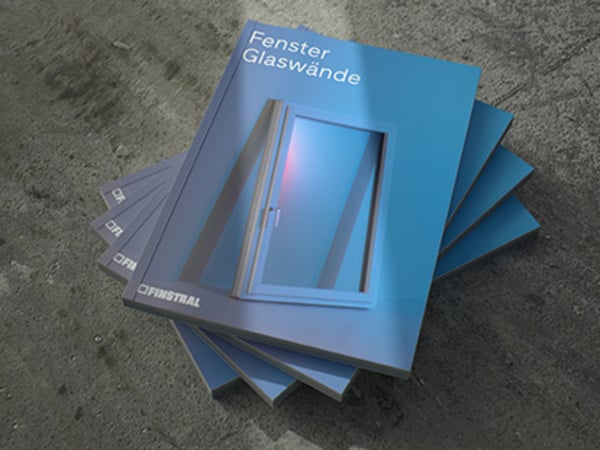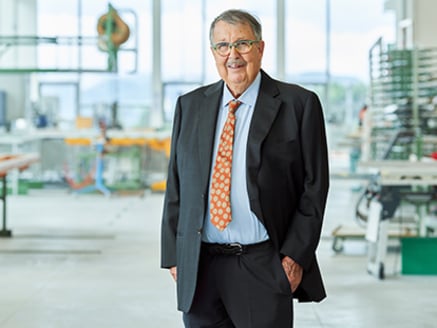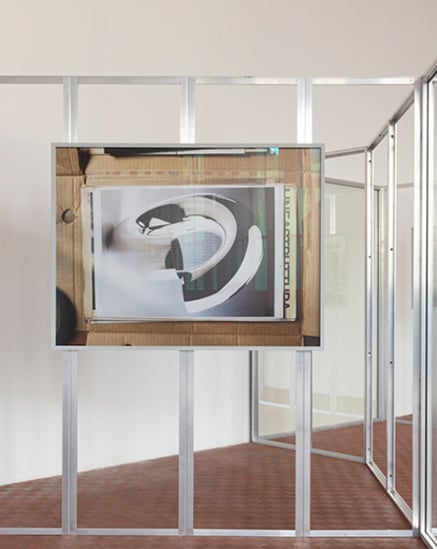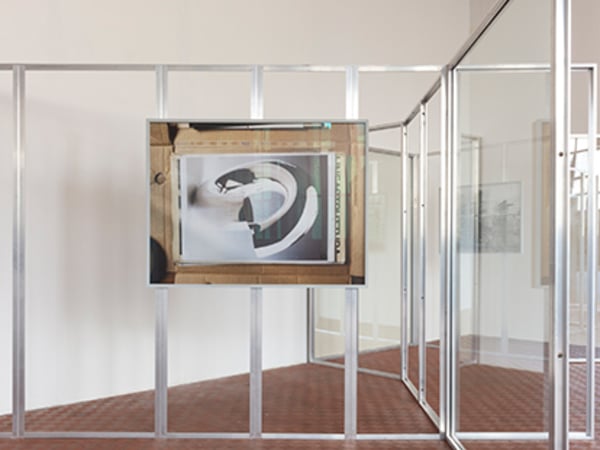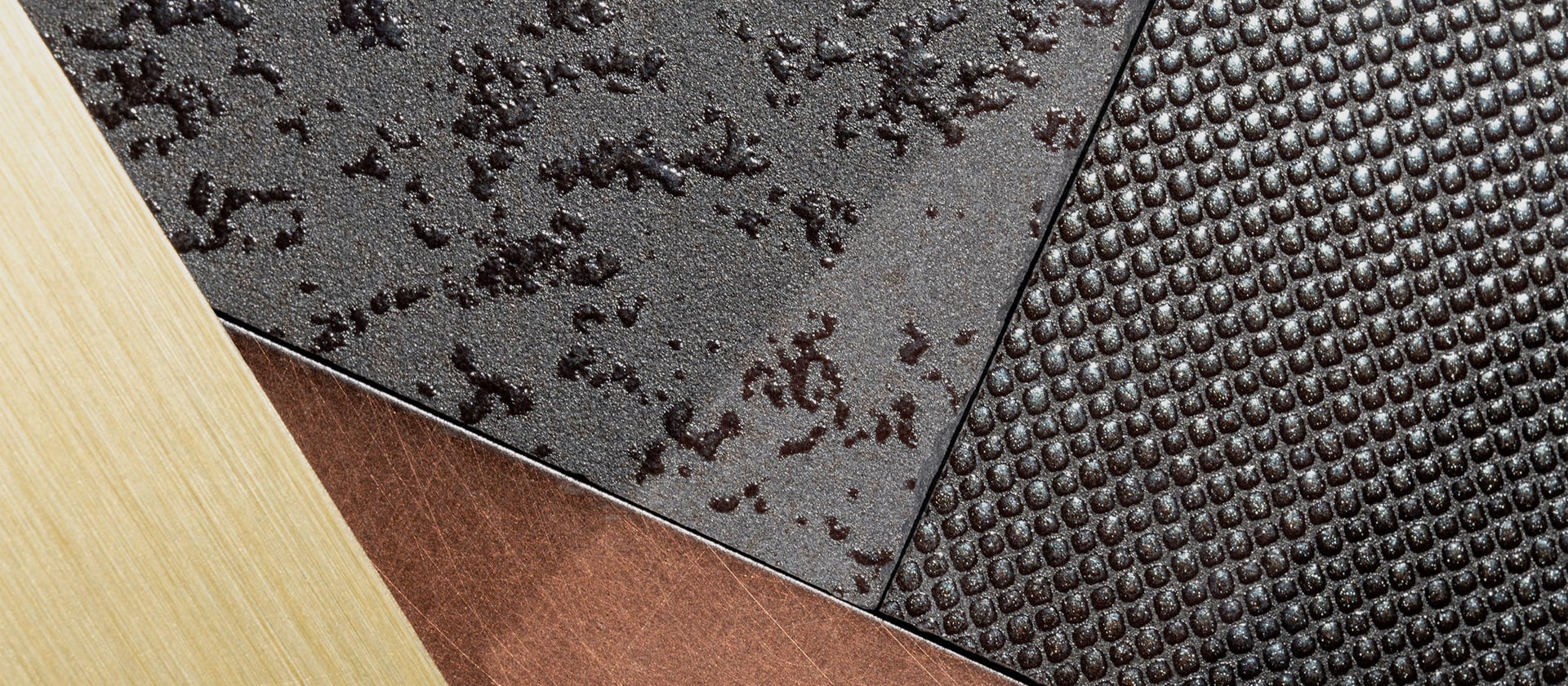
The multiplication of diversity.
Innovative frame coverings create completely new possibilities for window design – with no restrictions.
When it comes to window construction, PVC, aluminium and wood all determine the frame design: the variants for combination are nevertheless often limited. Finstral has however long been consistent in the modularity of its range, meaning that almost everything goes together with everything else when it comes to window configuration. And now, the newly developed “Inlay” coverings have been added to the mix: these inlays allow Finstral frames to be fitted with precious wood, metal or ceramic variations on the inside – yet with no restriction on the selection of other functions and features. This in turn permits windows to add even more variety and individuality to the design of interiors. We recount the story of the development of Inlay.
Anyone visiting Finstral’s head office at Unterinn in South Tyrol, located at an altitude of 1,000 metres up on the Ritten plateau, will be amazed by the spectacular panorama and the distant views over the mountains. Perhaps it is therefore no wonder that this is where new ideas are born – ideas that are sometimes also bold and far-reaching in nature. At the same time, the first few exchanges at this family business lead you quickly to realise that everyone here has their feet firmly on the ground: the term “down-to-earth” could have been invented for these particular inhabitants of South Tyrol. Thinking outside the box yet keeping within the bounds of the realistic: this combination means a solution such as the Inlay frame covering is first plausible, then feasible.
In this case it all began with a student from South Tyrol who came home, so to speak, to Finstral during the practical phases of his joint degree in construction and façade technology at the DHBW (Baden-Wuerttemberg Cooperative State University) at Mosbach in Germany. Alex Ploner experienced all of Finstral’s trades while he was there: “For example, I was assigned to profile extrusion, working on insulation glass production” recalls the 24-year-old. “And of course to window installation.” At head office in Unterinn, he moved from office to office, finally ending up in systems technology, which addresses the fundamental design issues of window development. It was there that, as part of his bachelor’s thesis, Alex Ploner was in June 2020 given the opportunity to work on a large and challenging problem.
“I was asked to further develop the existing modular units in terms of function and aesthetics”, is how Ploner matter-of-factly describes the task that was set him by his bosses at Finstral. Modular units? This term might sound fun and even simple, but the reality was anything but. “We have actually been working for a long time now on consistently focussing our range on modularity” confirms Joachim Oberrauch, co-owner and managing director of Finstral, who is responsible for product development. “Colours, materials, frame shape, ease of use: the aim is for everything, where possible, always to work with everything else when configuring a Finstral window. And we were already quite a long way down this path when Alex started to rack his own brains.” Oberrauch grins: “But he wasn’t supposed to have it too easy either.”
Over the course of four months Alex Ploner pursued various approaches to further apply and expand the strengths of modularity. In functional terms, he developed proposals in the areas of break-in resistance, fire protection – even for withstanding bullets. In terms of aesthetics, he set out to expand Finstral’s already wide range of materials, including PVC, aluminium and wood variants – indeed to amplify it. “I thought about whether and how very different materials could be added to the existing frame profile, all with as little processing effort as possible.” At a certain point, then, he came up with the perfect solution: “What about using an aluminium support profile as an additional inner module into which we would then simply insert strips of material? It didn’t matter if it could or couldn’t be milled or moulded: any material would work and give the window a totally new look – without affecting either its function or its features.”
Following regular exchanges of ideas with Ploner, his line manager Franz Gufler and Joachim Oberrauch quickly came to a decision: to further pursue this inlay approach. Using a 3D printer, the former undergraduate student produced an initial holding profile into which could be inserted standardised widths of materials that were already available at Finstral, as well as completely different materials: precious woods, metals, even ceramics... with impressive results. “We were immediately convinced of the obvious advantages” says Franz Gufler straightforwardly. “We could produce windows with a completely new look, with little cost in terms of development or production.” This is precisely the key to modularity: maximising variety while minimising complexity, and ensuring it is all manageable. “Of course, in this case too, as always, the devil was in the detail”, says Franz Gufler. “A lot had to be clarified in his bachelor’s thesis and afterwards, especially when it came to the actual production conditions. But we succeeded, and it was well worth it.”
After three years of development, Finstral’s Inlay is now on the market. Customers can choose from five inlays of precious wood, five of metal and twelve of ceramics for the inside of the window and select one of the over 250 aluminium colours that Finstral offers for support profiles. “And this without any restriction when it comes to selecting other features, such as frame shape, shading or break-in protection”, emphasises Franz Gufler once more. “Inlay is available for double-sash windows as well as for sliding doors. A frame can even have a different Inlay variant from the sash frame!” Joachim Oberrauch adds: “With Inlay, we have created even more design options for interior architects and designers, as is usual for furniture. This allows even more specific details to be chosen for each individual room, or even individual windows.” Alex Ploner goes into precise detail: “There exists a total of 41,594,475,000 possible combinations of materials, colours and sash shapes for all aesthetic modules – interior and exterior.”
And what about Alex Ploner, who played such a decisive role in the development of Inlay? He received an excellent result for his thesis, “Although I graded him a little more harshly than his professor”, grins Joachim Oberrauch. Obviously, Alex was hired nonetheless, continuing his work on the multiplication of diversity in the field of systems technology, in a workplace that always has an eye to the future. During his studies he ultimately learnt that many people dream of great freedom. The truly great – and enormously fascinating – task is to realise it.
Anyone visiting Finstral’s head office at Unterinn in South Tyrol, located at an altitude of 1,000 metres up on the Ritten plateau, will be amazed by the spectacular panorama and the distant views over the mountains. Perhaps it is therefore no wonder that this is where new ideas are born – ideas that are sometimes also bold and far-reaching in nature. At the same time, the first few exchanges at this family business lead you quickly to realise that everyone here has their feet firmly on the ground: the term “down-to-earth” could have been invented for these particular inhabitants of South Tyrol. Thinking outside the box yet keeping within the bounds of the realistic: this combination means a solution such as the Inlay frame covering is first plausible, then feasible.
In this case it all began with a student from South Tyrol who came home, so to speak, to Finstral during the practical phases of his joint degree in construction and façade technology at the DHBW (Baden-Wuerttemberg Cooperative State University) at Mosbach in Germany. Alex Ploner experienced all of Finstral’s trades while he was there: “For example, I was assigned to profile extrusion, working on insulation glass production” recalls the 24-year-old. “And of course to window installation.” At head office in Unterinn, he moved from office to office, finally ending up in systems technology, which addresses the fundamental design issues of window development. It was there that, as part of his bachelor’s thesis, Alex Ploner was in June 2020 given the opportunity to work on a large and challenging problem.
“I was asked to further develop the existing modular units in terms of function and aesthetics”, is how Ploner matter-of-factly describes the task that was set him by his bosses at Finstral. Modular units? This term might sound fun and even simple, but the reality was anything but. “We have actually been working for a long time now on consistently focussing our range on modularity” confirms Joachim Oberrauch, co-owner and managing director of Finstral, who is responsible for product development. “Colours, materials, frame shape, ease of use: the aim is for everything, where possible, always to work with everything else when configuring a Finstral window. And we were already quite a long way down this path when Alex started to rack his own brains.” Oberrauch grins: “But he wasn’t supposed to have it too easy either.”
Over the course of four months Alex Ploner pursued various approaches to further apply and expand the strengths of modularity. In functional terms, he developed proposals in the areas of break-in resistance, fire protection – even for withstanding bullets. In terms of aesthetics, he set out to expand Finstral’s already wide range of materials, including PVC, aluminium and wood variants – indeed to amplify it. “I thought about whether and how very different materials could be added to the existing frame profile, all with as little processing effort as possible.” At a certain point, then, he came up with the perfect solution: “What about using an aluminium support profile as an additional inner module into which we would then simply insert strips of material? It didn’t matter if it could or couldn’t be milled or moulded: any material would work and give the window a totally new look – without affecting either its function or its features.”
Following regular exchanges of ideas with Ploner, his line manager Franz Gufler and Joachim Oberrauch quickly came to a decision: to further pursue this inlay approach. Using a 3D printer, the former undergraduate student produced an initial holding profile into which could be inserted standardised widths of materials that were already available at Finstral, as well as completely different materials: precious woods, metals, even ceramics... with impressive results. “We were immediately convinced of the obvious advantages” says Franz Gufler straightforwardly. “We could produce windows with a completely new look, with little cost in terms of development or production.” This is precisely the key to modularity: maximising variety while minimising complexity, and ensuring it is all manageable. “Of course, in this case too, as always, the devil was in the detail”, says Franz Gufler. “A lot had to be clarified in his bachelor’s thesis and afterwards, especially when it came to the actual production conditions. But we succeeded, and it was well worth it.”
After three years of development, Finstral’s Inlay is now on the market. Customers can choose from five inlays of precious wood, five of metal and twelve of ceramics for the inside of the window and select one of the over 250 aluminium colours that Finstral offers for support profiles. “And this without any restriction when it comes to selecting other features, such as frame shape, shading or break-in protection”, emphasises Franz Gufler once more. “Inlay is available for double-sash windows as well as for sliding doors. A frame can even have a different Inlay variant from the sash frame!” Joachim Oberrauch adds: “With Inlay, we have created even more design options for interior architects and designers, as is usual for furniture. This allows even more specific details to be chosen for each individual room, or even individual windows.” Alex Ploner goes into precise detail: “There exists a total of 41,594,475,000 possible combinations of materials, colours and sash shapes for all aesthetic modules – interior and exterior.”
And what about Alex Ploner, who played such a decisive role in the development of Inlay? He received an excellent result for his thesis, “Although I graded him a little more harshly than his professor”, grins Joachim Oberrauch. Obviously, Alex was hired nonetheless, continuing his work on the multiplication of diversity in the field of systems technology, in a workplace that always has an eye to the future. During his studies he ultimately learnt that many people dream of great freedom. The truly great – and enormously fascinating – task is to realise it.
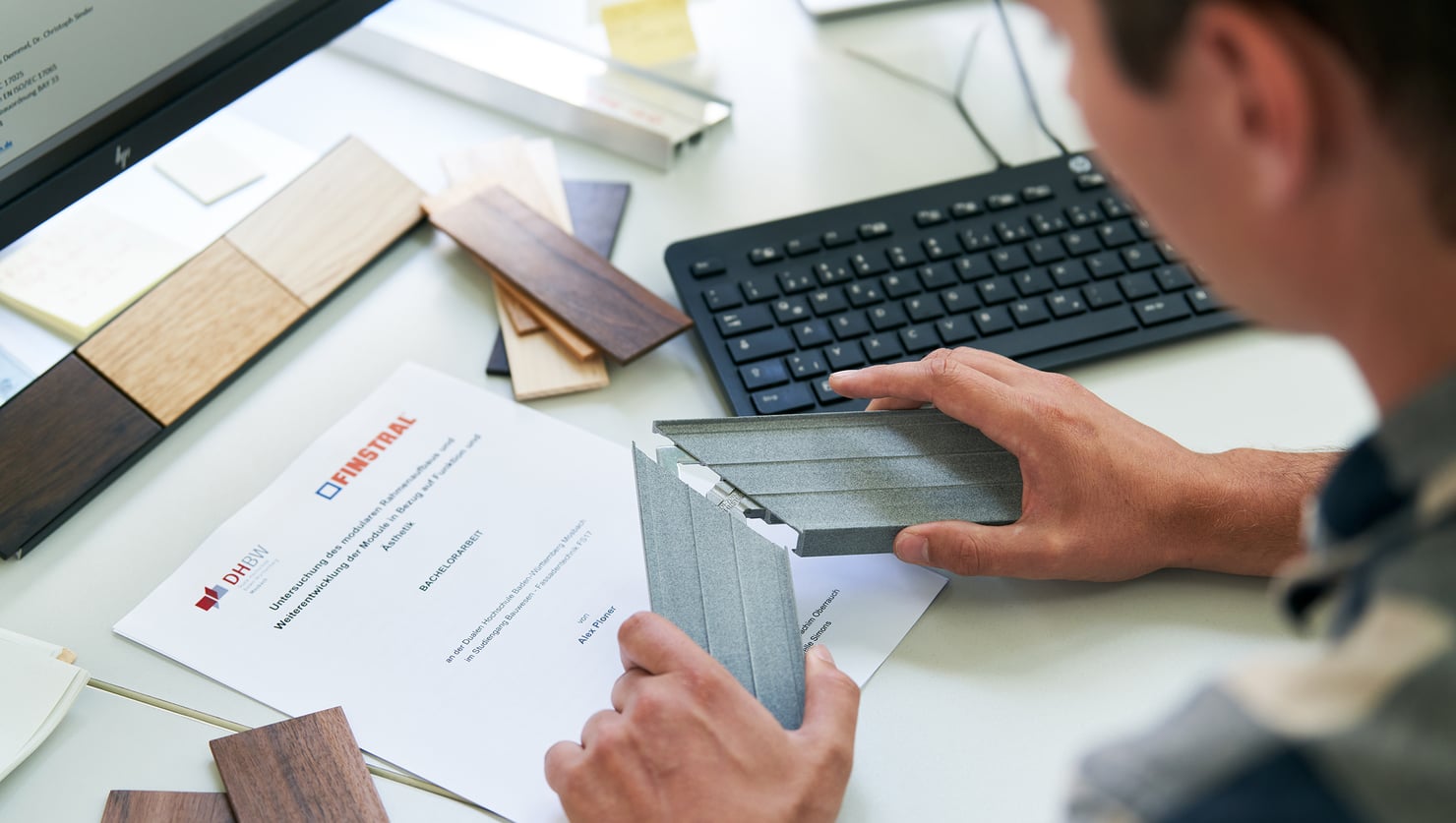
How it all began: for his bachelor’s thesis, Alex Ploner developed the module for Inlay – inlays made of different materials that are inserted into an aluminium support profile. The initial model was produced using a 3D printer.
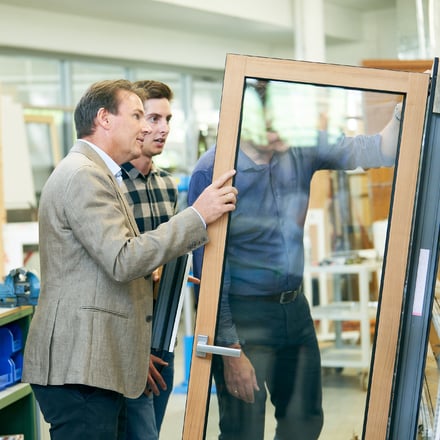
Inlay in Finstral’s test laboratory: Finstral co-owner Joachim Oberrauch (left), Alex Ploner (centre) and Head of Systems Technology Franz Gufler (right) examine the effect of a window frame fitted with precious wood. Remarkably, all functional and aesthetic window configurations can be combined with Inlay.
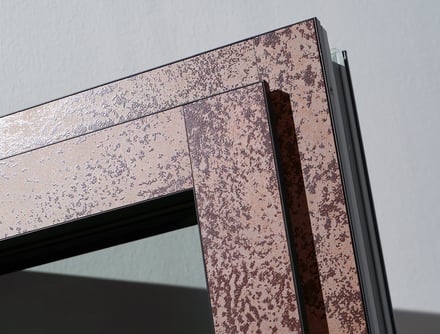
A fascinating depth that is pleasantly rough to the touch: multi-layered firing of the ceramic option from Inlay creates natural-looking surfaces that constantly change according to the light incidence to give window frames a completely new look.
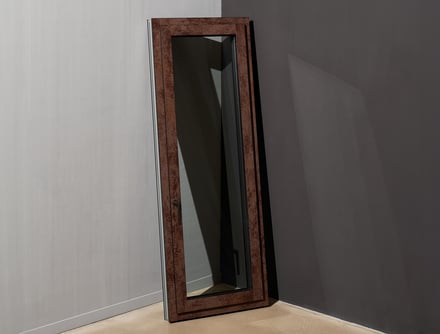
The narrowest frames with a special touch: precious woods are valuable and rare, yet the Inlay option permits their use in a resource-saving, aesthetically compelling way. As a result, windows are increasingly becoming a defining component of interior design.
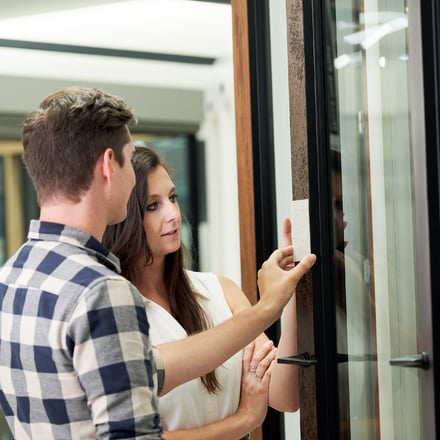
Three materials in a total of 22 variants – and 250 colours for the aluminium support profile. Inlay multiplies the variety that Finstral already offers for the individual composition of windows for a total of 41,594,475,000 possible combinations.
Still want more?
See here for further interesting reading matter.
